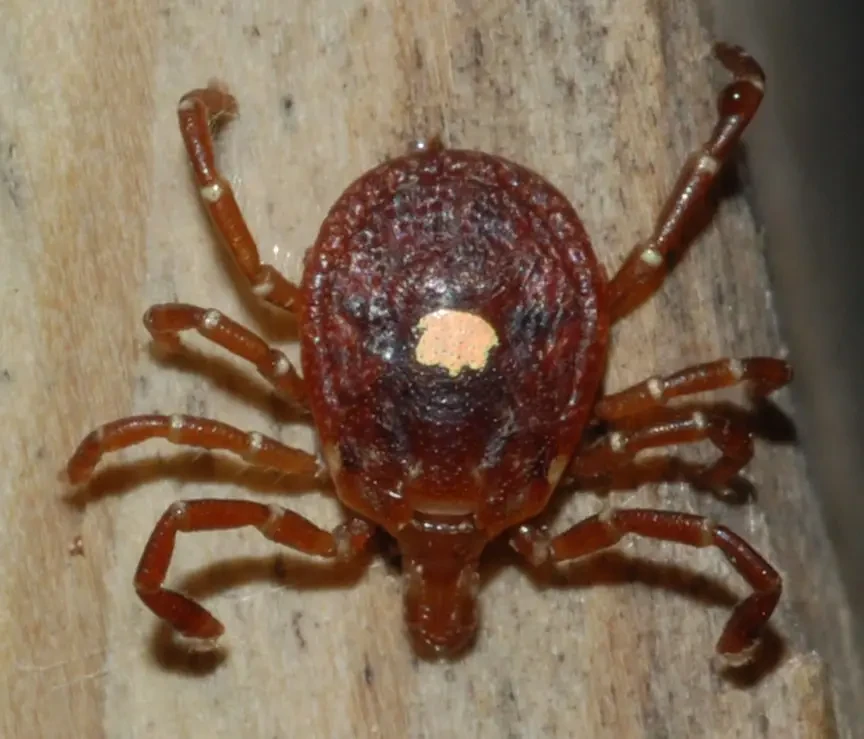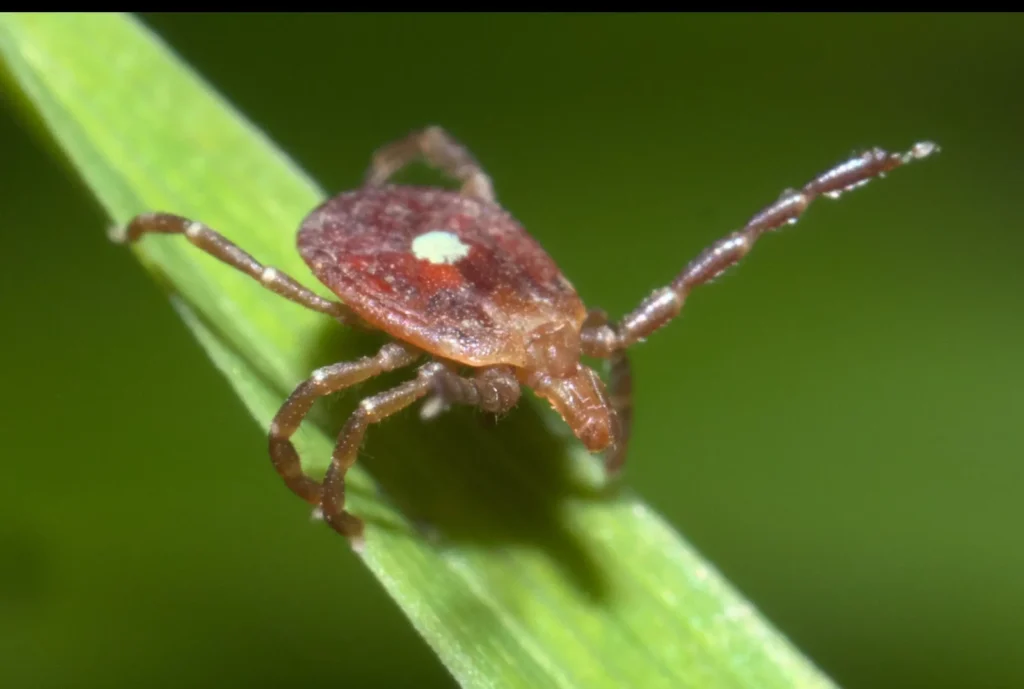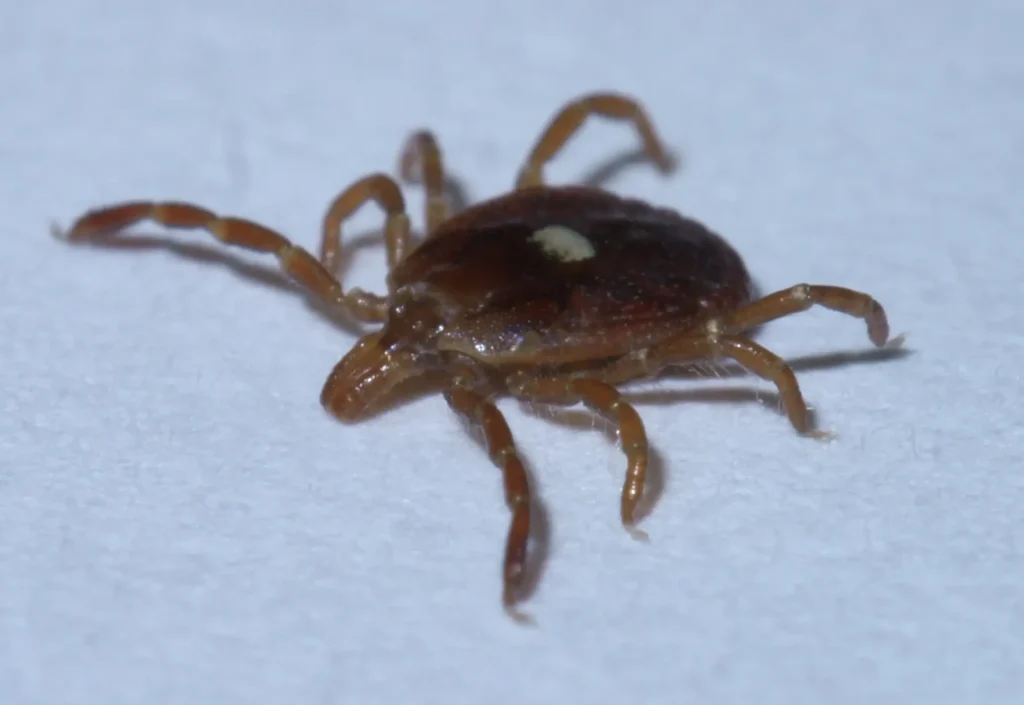Tick Amblyomma americanum, known as the "lone star" (Lone Star Tick), is one of the most aggressive tick species in North America. Its name comes from the white star-shaped spot on the back of the female. This parasite feeds on the blood of animals and humans and can carry dangerous diseases, including ehrlichiosis, tularemia, and alpha-gal syndrome, which causes an allergy to red meat.
Due to its ability to actively search for prey and high abundance in warm regions, Amblyomma americanum is a serious threat to human and animal health. In this article, we will look at its biological characteristics, life cycle, health hazards, and effective methods of protection against bites.

Scientific classification
✔ The Kingdom: Animals (Animalia)
✔ Type: Arthropods (Arthropoda)
✔ Class: Arachnids (Arachnida)
✔ Row: Ticks (Ixodida)
✔ Family: Ixodidae (hard ticks)
✔ Gender: Amblyomma
✔ View: Amblyomma americanum
Appearance and features
✔ Size:
• Larvae – less than 1 mm
• Nymphs – 1.5–2 mm
• Adult ticks – 3–4 mm (up to 7 mm after blood saturation)
✔ Colour:
• Reddish brown
• Females have a white spot on their back in the shape of a "star"
✔ Body type:
• Oval shape
• Long mouthparts for deep attachment to the skin
• Three stages of development: larva, nymph, adult tick
A distinctive feature Amblyomma americanum is its aggressiveness. Unlike other mites that wait for prey on plants, this species actively moves and attacks warm-blooded creatures.

Distribution and habitat
🌍 Geographic distribution:
✔ Southeast USA (main range)
✔ Midwest and Northeast USA
✔ Found in Mexico and Canada
🏡 Where does it live?
✔ Forests with dense vegetation
✔ Fields, meadows, pastures
✔ Roadsides, paths, gardens
✔ Lives on mammals, birds and humans
Life cycle
✔ Development duration: 2–3 years
✔ Three stages: larva → nymph → adult tick
✔ Each stage requires blood to progress to the next.
1️⃣ Larvae (6 legs): Suck blood from small animals (mice, rabbits).
2️⃣ Nymphs (8 legs): attack larger animals and humans.
3️⃣ Adults: They feed on large animals and humans, and females lay up to 5,000 eggs after they are full.
The life cycle of a tick lasts from two to three years.
Dangers to human health
🔴 Amblyomma americanum is a carrier of several dangerous diseases:
1️⃣ Ehrlichiosis
• Bacterial infection (Ehrlichia chaffeensis)
• Symptoms: fever, headache, muscle pain, fatigue
• Can lead to serious complications without treatment
2️⃣ Tularemia (Francisella tularensis)
• Causes fever, swollen lymph nodes, and skin ulcers
• May affect the lungs
3️⃣ Alpha-gal syndrome (meat allergy)
• Immune response to carbohydrate α-Galcontained in red meat
• Symptoms: rash, swelling, digestive problems, anaphylactic shock
• Occurs due to a bite Amblyomma americanum, which transmits α-Gal into the human body
4️⃣ Southern Tick-Associated Rash Illness (STARI)
• Similar to Lyme disease, but without serious consequences
• Causes a rash around the bite site, fatigue, joint pain

How to protect yourself from a bite?
🛑 Prevention methods:
✔ Avoid tall grass and dense vegetation
✔ Wear closed clothes, tuck your pants into your socks
✔ Use repellents (DEET, permethrin)
✔ After a walk, check your body for ticks
✔ Keep the yard well-groomed, mow the grass
🔄 What to do if a tick has attached itself?
1️⃣ Pull out the tick with tweezers, grabbing it as close to the skin as possible
2️⃣ Do not twist, but pull evenly
3️⃣ Treat the bite site with an antiseptic
4️⃣ Monitor symptoms for 2–3 weeks

Interesting facts about Amblyomma americanum
🕷 This tick can sense its prey by its CO₂ emissions from up to 10 meters away
🕷 Its mouthparts are longer than most other tick species, making it difficult to remove.
🕷 Females can lay up to 5,000 eggs after a single feeding
🕷 Ticks of this species are active even in winter if the temperature is above 10°C
Conclusion
Amblyomma americanum – one of the most aggressive ticks in North America, which not only carries dangerous diseases, but is also capable of changing a person's diet, causing an allergy to red meat. Its activity, ability to move quickly and attack its victim make it a serious threat.
However, following simple preventive measures can significantly reduce the risk of being bitten. Using repellents, wearing the right clothing, and checking carefully after a walk will help you avoid encountering this dangerous parasite.
🕷 Have you ever been bitten by a tick? How do you protect yourself? Share your experiences in the comments!